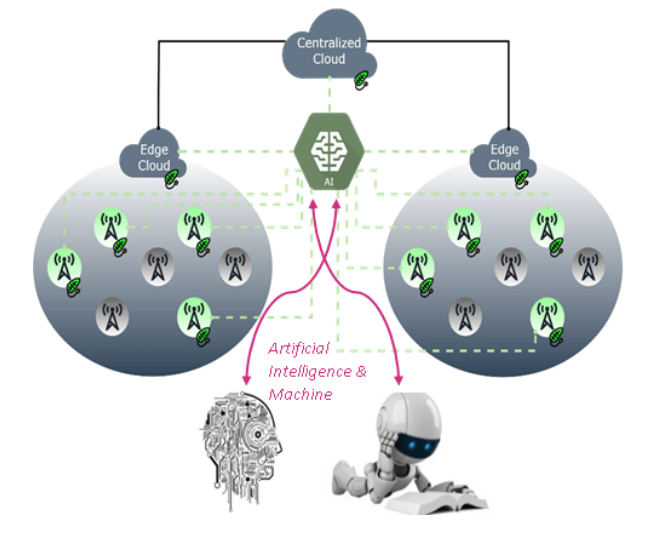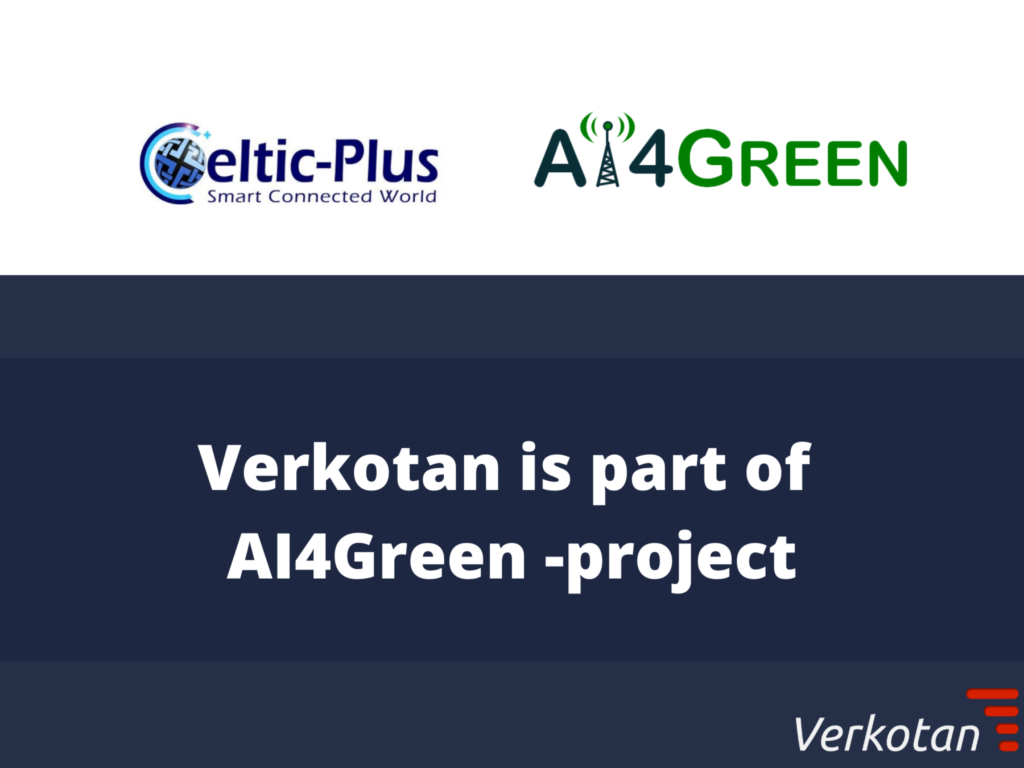Main Focus
AI4Green focuses on the following areas:
- Data collection, measurements and analysis.
- Anomaly and fault detection in mobile networks with crowd-sourced data.
- Joint communication and sensing for environmental awareness for intelligent beamforming
- AI assisted energy savings in 4G live networks
- AI assisted energy savings in 5G and beyond networks with digital twin
- Cloud and AI-native network architectures to enable flexible user-centric resource allocation for energy-efficiency
Approach
- Measurement probes are developed for real time energy consumption measurements in base stations. ML is used for energy consumption modeling.
- A large set of mobile traffic data is analyzed with successful classification of base stations with different traffic behaviors. Base stations are classified based on temporal and geo-spatial traffic behavior to make intelligent resource allocation at different times of the day at different locations.
- Anomaly and fault detection demonstration is performed both in Tele2 and Turkcell networks by using machine learning on crowd sourced data in combination with the network data.
- For 4G networks, data driven, AI assisted energy saving algorithms developed and tested in Turkcell’s mobile networks focusing on carrier shut down and sector shut down. Set of machine learning and prediction algorithms are developed and adapted to decide on when and where to activate these features considering the risks of mobile user service quality degradations at the service quality degredations.
- Data driven, AI assisted energy saving algorithms are developed using 3 different levels of advanced sleep modes in 5G base stations using Tele2 network data by creating a digital twin. Several reinforcement learning algorithms are designed and adapted to make decisions in the network regarding when and how deep to sleep.
- A novel network management framework is proposed with a digital twin continuously analyzing the probability of risk and orchestrating the usage of ML.
- We have developed innovative intelligent network architectures with the joint planning of computational and communication resources in addition to datadriven estimation and optimization approaches to energy consumption for network slicing.
- End-to-end network slicing is optimized for the first time considering the energy consumption in addition to the QoS guaranteeing.
- Cell-free Massive MIMO on top of Virtualized C-RAN is proposed as a more flexible architecture enabling network resources to adapt and cloud resources to be shared between different radio access points when traffic load is low. Data rate increase around x1.7 is achieved with up to 14% energy saving compared to the traditional cellular system.

Achieved Results
Project achieved its goals in terms of energy savings and fault/detection testing and demonstrating solutions on live networks. In the most crowded area in Istanbul, we demonstrated up to 14% energy savings in live networks by AI assisted sector and carrier shut down. 10% extra energy savings is achieved with the proposed approach compared to existing model-based approach when it comes to sector shut down. Normally when the traffic load is high during day time, energy saving features are not activated, especially during special events with large crowds gathering to avoid risk of performance degradation. Via mobility prediction, modeling and analysis of temporal and geo-spatial crowd movements, energy saving can be selectively enabled in more than 50% of the cells during 5 hours right after a football game in the city center. Deep packet inspection functionality is developed in Tele2 networks in two seconds granularity.
New architectures and communication technologies such as Cellfree massive MIMO on top of virtualized cloud RAN is studied with intelligent access point clustering and switching off. AI is used to adaptively configure 5G base stations with large antenna elements together with advanced sleep modes bringing in energy savings in the range of 30 to 90%. This high percentage comes from the deep sleep capability of the modern technologies in combination with our ML algorithms.
Novel fault detection solutions has been developed avoiding extra drive tests and fuel consumption thanks to the data analytics and implementation of AI algorithms.
For vehicular communications, joint radar sensing and communication is studied. It is shown that 50 % energy saving can be achieved compared to the case of vehicles equipped with separate radar and communication devices. A ray tracing tool is developed and tested in a field trial to model signal propagation.
In C-RAN based cell-free massive MIMO, Deep RL is adapted for switching Access Points(APs) ON/ OFF with the dynamic traffic. 30% energy-efficiency improvement is obtained compared to the modelbased algorithm for AP switching off.
Impact
Project resulted in 6 new products and 11 improved products demonstrating a high impact in business. Expected return of investment (RoI) within the next 3 years is 1- 50x depending on partner. 12-14 number of new permanent employees hired or expected to be hired by the partner organisations or spin-off companies due to activities generated by project results are reported. During the project 7 field trials have been performed within the following areas: anomaly detection, energy savings in live networks at Turkcell and Tele2, and tests of UXPERT framework. 27 Scientific articles were published in journals and presented in international conferences. 4 PhD and 6 Ms theses were supported by the project (KTH, ISEL, CELFINET, PI WORKS). 20 Disseminations and outreach activities including project presentations have been reported.
Participants in project A14Green
- Allbesmart, Portugal
- BI Nordic AB, Sweden
- Celfinet, Portugal
- DA Group, Finland
- Infovista AB, Sweden
- Institut Mines Télécom, France
- Instituto Politecnico de Castelo Branco, Portugal
- Instituto Superior de Engenharia de Lisboa, Portugal
- Orange SA, France
- PI Works, Turkiye
- KTH Royal Institute of Technology, Sweden
- Tele2 Sverige AB, Sweden
- Turkcell, Turkiye
- TURKGEN, Turkiye
- University of Oulu, Finland
- Verkotan Oy, Finland
- VTT Technical Research Centre of Finland Ltd., Finland
Co-ordinator:
Cicek Cavdar
KTH Royal Institute of Technology, Sweden
E-mail: cavdar@kth.se
Project manager:
Martina Lidman
Tele2, Sweden
E-Mail: martina.lidman@tele2.com
Project Website
www.celticnext.eu/project-ai4green
https://ai4green.celfinet.com
Follow our social media channels to keep up with the latest news in the world of wireless technology!
